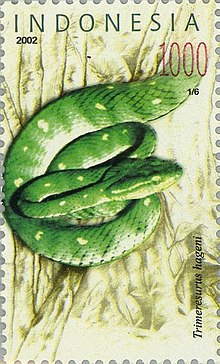Trimeresurus hageni
| Trimeresurus hageni | |
|---|---|

| |
| Scientific classification | |
| Domain: | Eukaryota |
| Kingdom: | Animalia |
| Phylum: | Chordata |
| Class: | Reptilia |
| Order: | Squamata |
| Suborder: | Serpentes |
| Family: | Viperidae |
| Genus: | Trimeresurus |
| Species: | T. hageni
|
| Binomial name | |
| Trimeresurus hageni (Lidth de Jeude, 1886)
| |
| Synonyms[3] | |
Trimeresurus hageni, commonly known as Hagen's pit viper[4] and Hagen's green pit viper,[1] is a species of venomous snake in the subfamily Crotalinae of the family Viperidae. The species is native to Southeast Asia. There are no subspecies that are recognized as being valid.[5]
Etymology[edit]
The specific name, hageni, is in honor of German naturalist Dr. Bernhard Hagen, who collected mammals, birds, reptiles, and insects in the eastern part of Sumatra.[6][7]
Description[edit]

Scalation of T. hageni includes 21 rows of dorsal scales at midbody, 176–198 ventral scales, 63–89 subcaudal scales, and 9–12 supralabial scales.[4] The lectotype has a total length (including tail) of 97 cm (38 in).[3]
Geographic range[edit]
T. hageni is found in Peninsular Thailand, Peninsular Malaysia, East Malaysia (Borneo), and Indonesia (Sumatra and the nearby islands of Bangka, Simalur, Nias, Batu, and the Mentawai Islands).
The type locality given is "Sumatra ... [and] island of Banka". Brongersma (1933) emended this to "Deli, Sumatra".[2]
Habitat[edit]
The preferred natural habitat of T. hageni is forest, at altitudes of 100–300 m (330–980 ft).[1]
Behavior[edit]
T. hageni is arboreal and nocturnal.[1]
Diet[edit]
T. hageni preys upon amphibians and lizards.[1]
Reproduction[edit]
References[edit]
- ^ a b c d e Grismer, L.; Chan-Ard, T. (2012). "Trimeresurus hageni ". IUCN Red List of Threatened Species. 2012: e.T191906A2013598. doi:10.2305/IUCN.UK.2012-1.RLTS.T191906A2013598.en. Retrieved 20 November 2021.
- ^ a b McDiarmid RW, Campbell JA, Touré TA (1999). Snake Species of the World: A Taxonomic and Geographic Reference, Volume 1. Washington, District of Columbia: Herpetologists' League. 511 pp. ISBN 1-893777-00-6 (series). ISBN 1-893777-01-4 (volume).
- ^ a b c Species Trimeresurus hageni at The Reptile Database www.reptile-database.org.
- ^ a b Gumprecht A, Tillack F, Orlov NL, Captain A, Ryabov S (2004). Asian Pit vipers. Berlin: GeitjeBooks. 1st Edition. 368 pp. ISBN 3-937975-00-4.
- ^ "Trimeresurus hageni ". Integrated Taxonomic Information System. Retrieved 28 July 2008.
- ^ Jentink FA (1888). "On a Collection of Mammals from East-Sumatra". Notes from the Leyden Museum 11 (6):17–30.
- ^ Beolens, Bo; Watkins, Michael; Grayson, Michael (2011). The Eponym Dictionary of Reptiles. Baltimore: Johns Hopkins University Press. xiii + 296 pp. ISBN 978-1-4214-0135-5. (Trimeresurus hageni, p. 113).
Further reading[edit]
- Brongersma LD (1933). "Herpetological Notes I-IX". Zoologische Mededeelingen (Leiden) 16: 1-29. (Trimeresurus hageni, new combination).
- Das I (2012). A Naturalist's Guide to the Snakes of South-East Asia: Malaysia, Singapore, Thailand, Myanmar, Borneo, Sumatra, Java and Bali. Oxford, England: John Beaufoy Publishing. 176 pp. ISBN 978-1906780708.
- Lidth de Jeude, Th. W. van (1886). "On Cophias Wagleri Boie and Coluber sumatranus Raffles". Notes from the Leyden Museum 8 (10): 43–54. ("Bothrops Hageni", new species, pp. 53–54).
- Sanders KL, Malhotra A, Thorpe RS (2002). "A contribution to the systematics of two commonly confused pitvipers from the Sunda Region: Trimeresurus hageni and T. sumatranus ". Bulletin of the Natural History Museum London (Zoology Series) 68 (2): 107–111.

